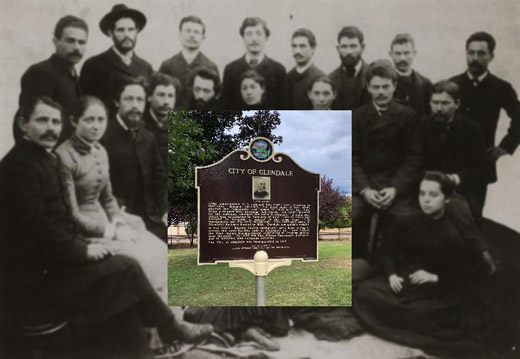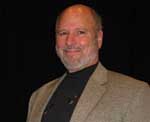
By Jerry Klinger

GLENDALE, Oregon — Historic markers are simple things. Some are a few words. Some are longer. Some are so long few read beyond the first line, if at all.
Every marker is a story. They are the stories of people, like you and me, who dreamed dreams, lived hopes, made choices, succeeded or failed. Some markers are about events that happened nearby, events that changed lives or even ended them.
All are the stories of our yesterdays, our todays and our children’s tomorrows.
Behind every story is a story. How a marker is made, how it got there, who paid for it or wrote the text is etherized in a keystroke. Yet, the physical presence, no hitting delete on a computer can change telling of the past, the marker remains – a silent witness.
September 12, 2018, the Jewish American Society for Historic Preservation, www.JASHP.org, dedicated its newest Jewish marker project, Glendale, Oregon.
Modern interstate I-5 follows an old wagon road, climbing into the mountainous terrain from the Umpqua Valley. The highway cut off Glendale, Oregon, isolating it in time and again in location, much like it had been over a hundred years and thirty years ago before the railroad came through. Glendale was a booming lumber town and today is a sleepy, small lumber town. The history of the town, known and forgotten, is intimately linked to the Jewish American experience.
Glendale was founded by a Jewish American, Solomon Abraham. Abraham worked for the railroad.
Two years ago, JASHP approached Jewish groups in Roseburg and Ashland. We approached the Oregon Jewish Museum and Holocaust Documentation Center in Portland and expanded our marker offer to include the First Jewish House of Worship in the Pacific Northwest, Oregon’s, Congregation Beth Israel – 1859. We approached a local group near Glendale. None worked out.
Before chalking up Glendale as a great Jewish story that would never be told, we decided to give it one more try.
JASHP pays for the marker projects. We provide the technical expertise and the foundry. We assist with the text if asked. JASHP has done projects in 33 states and five countries. But… without even one person, locally, on the ground, who is willing to partner with us to tell their story, the Jewish story dies. Many have died. Ironically, most of the Jewish historical markers that JASHP has done are because of the willingness of non-Jews to tell their story…
JASHP wrote directly to the City of Glendale and made the offer.
They were astonished, and we were astonished.
They were astonished because no one contacts the small town of Glendale and offers to give them a historical marker about them that costs thousands of dollars to produce. Dawn Russ, the City Administrator, wanted to know what we wanted in exchange.
Our condition was the same with every community that we partner with. If there is a Jewish story or a Jewish connection, it must be recognized in the text.
Glendale choose the design, the format, the image, even the color. They wrote the text with suggestions from JASHP.
Mayor Adam Jones presented the marker proposal to the City Council. The offer was accepted. A story I thought was never to be told was going to be told.
To my astonishment, when all I was hoping for was a simple recognition that Jewish New Odessa existed became a key part of their writing of the marker text.
Historic Marker Text
“After construction of a railroad line South from Roseburg in 1881-1883, Solomon Abraham, the local right of way agent, platted the community and named it Julia after his wife. After a dispute with Abraham, A.F. Morris, the Chief Engineer for the railroad, changed the name to Glendale. A Julia post office was established in February of 1883, and its name was changed to Glendale in August of the same year. L.D. Montgomery was the first Postmaster. Fire destroyed much of Glendale’s business district in 1928 and it was rebuilt.
In the 1880’s, Russian-Jewish immigrants came here trying to escape the anti-Semitic rule of Alexander III. New Odessa, the first Jewish Communitarian Community in America settled near Glendale. By 1888 the New Odessa Community disbanded due to political and religious divisions.
The City of Glendale was incorporated in 1901.”
The New Odessa Jewish immigrants yearned for a constitutional form of government that would protect Jews from the centralized autocracy and aristocracy they had known in Russia. They were idealistically motivated by a radical Jewish solution to the “Jewish Problem.” The solution, named Am Olam, “The Eternal People”, advocated for socialist, revolutionary, agricultural communes. It was founded by Mania Bakl and Moses Herder.
Bakl and Herder called for the creation of the communes in America because in Russia it was impossible. They dreamed of owning land, something Jews were forbidden to do in Russia. They dreamed of a pure society smoothly flowing with communitarian values of Marxism, and where men and women were equal. They believed in a society where their labors were shared communally for the benefit of each other.
The New Odessa immigrants pooled their resources and sailed to New York.
Establishment American Jewry did not want more Eastern Jews who were frighteningly different from themselves. They did not want the Russian Jewish immigrants to settle in New York and threaten their hard won “Yeki”, German Jewish assimilation into American life. They feared reawakening anti-Semitism.
The Yekis had nothing to fear. The New Odessa Jews had no intention of settling in New York. They wanted to be farmers. New York Jewry’s, Hebrew Emigrant Aid Society arranged for them to be sent as far West as possible. The agriculturally inexperienced, undercapitalized and naïve Jewish refugees were connected to Solomon Abraham in Oregon. He needed people to settle and develop the lands along the railroad. He settled the New Odessans near Glendale.
760 acres were purchased on credit with Abraham’s help. Only 160 acres were suitable for agriculture. The men were forced to cut timber and sell to the railroad. The women tried but were physically unable to do the heavy labor. The community lived in a modified barn where privacy was limited. Equality of sexes led to sexual tensions and multiple associations. Community fragmented as socialism decayed and some members receiving equal benefits did not contribute equally to the labor.
Without structure and centralized leadership, factions and individualism emerged. New Odessa fractured and could not make payment on the farm’s mortgage. The communitarian effort collapsed in bankruptcy. The community disintegrated and dispersed.
The New Odessa Jews moved into the mainstream of American life. Three became doctors, two lawyers, two druggists, one a teacher, another an engineer and a few became individual farmers in Oregon. New Odessan, Peter Fireman went back to school to study chemistry. His discoveries made him a multi-millionaire.
The Russian Jewish Am Olam immigrants found their Utopias. Their Utopias were not communal but as free individuals in the unique experiment, America. The choices became theirs.
*
Jerry Klinger is President of the Jewish American Society for Historic Preservation, www.JASHP.org
Jerry: this is a beautifully written piece. Your comments in first few paragraphs on the importance of historic markers and the stories behind them are so moving. And now because of this marker, and your persistence and the foresight of the City of Glendale this story will be remembered . Good job.
Hi Jerry,
I enjoy your research and posts. The New Odessa immigrants have many fascinating stories to share. Thanks for being their spokesperson in this venue. Few of our ancestors likely realize the hardships and struggles of these amazing pioneers.
Last winter, I walked through ankle-deep snow in the frozen prairies of North Dakota in sub-zero temperatures. As a favor to my fiancée, my son and I were searching for the remnants of a Jewish agricultural settlement where her paternal great-great-grandfather from Russia had relocated before moving to more hospitable environments. My fiancée is a descendant of the organizer and a leader of this group. We have been researching their history and it has presented several challenges and rewards
We appreciate the research and support you’re undertaking to tell the stories of the New Odessa pioneers. We look forward to reading more of your posts.
Shalom,
Cade
Jerry,
Dorothy Canter is hosting a reception on October 11th at the Cosmos Club in DC to share our efforts to establish a National Historical Park honoring Julius Rosenwald and the Rosenwald Schools. I believe she told me she had reached out to you. We would love for you to attend this event. I believe she has sent you an invitation. If not, I’m sure she would be happy to do so.
Happy New Year
An interesting story.
Well told Jerry.